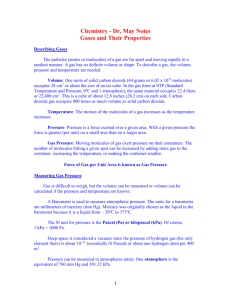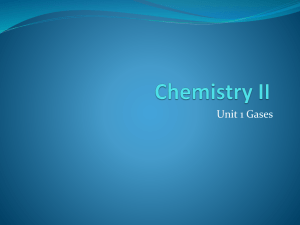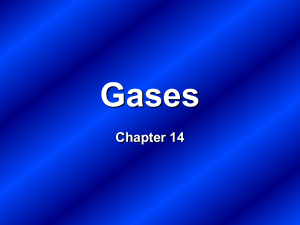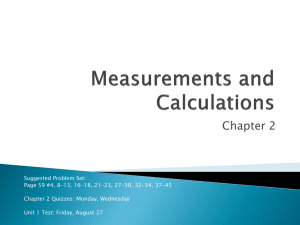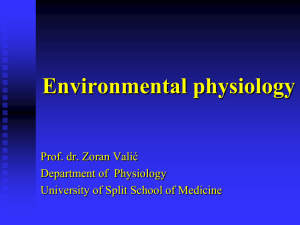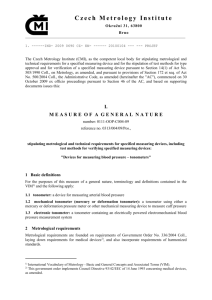SCH3U 9.2 Gas Laws Pressure:boyles_law
advertisement
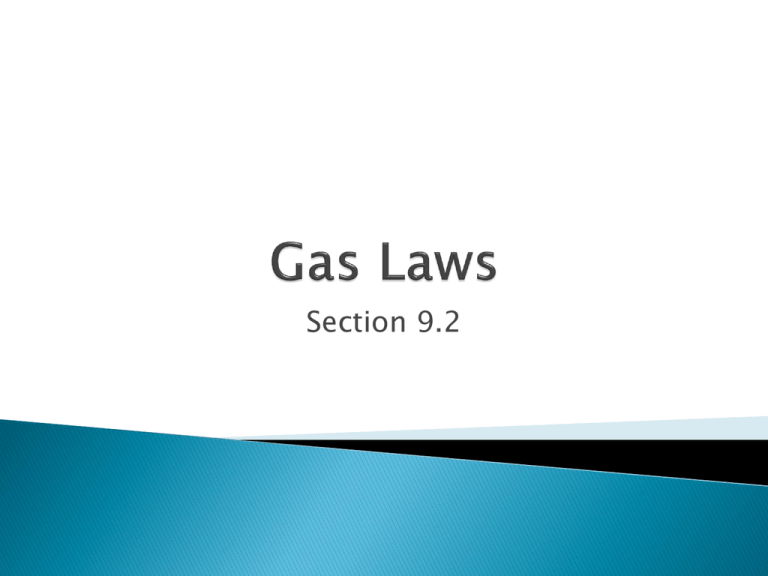
Section 9.2 Pressure: the force per unit area Kinetic Molecular Theory of Gases states that a gas consists of particles in constant, random, straightline motion. The pressure of a gas is the force exerted by the molecules as they collide with objects in their path (walls of the container) quantitative measurements on gases were first made by the English chemist, Robert Boyle (1627 - 1691). Boyle used two instruments to measure pressure: the manometer, which measures differences in pressure, and the barometer, which measures the total pressure of the atmosphere A barometer uses the height of a column of mercury to measure gas pressure The mercury is pushed up the tube from the dish until the pressure at the bottom of the tube (due to the mass of the mercury) is balanced by the atmospheric pressure units of pressure were originally based on the length of the column of liquid supported in a manometer or barometer. the most common of these units was the mm Hg (1 mmHg = 1 torr). however, the modern SI unit of pressure is the pascal, Pa (1 Pa = 1 N/m2) force per unit area exerted by air on all objects at sea level, it is 101.325 kPa (1 kPa = 1000 Pa) scientists used this value to define one standard atmosphere (1 atm) therefore, 1atm = 101.325 kPa Scientists have agreed to use a set of standard conditions for reporting properties of gases and other substances, SATP. Standard Ambient Temperature and Pressure (SATP) is 25° C and 100 kPa. Previous conditions used were referred to as STP (standard temperature and pressure) STP is 0° C and 101.325 kPa Unit Name Unit Symbol Definition/Conversion pascal Pa 1 Pa = 1 N/m2 atmosphere atm 1 atm = 101.325 kPa millimeters of mercury mmHg 760 mmHg = 1 atm = 101.325 kPa torr 1 torr = 1 mmHg torr Boyle used the manometer and barometer to study the pressures and volumes of different samples of different gases. The results of his studies can be summarized in a simple statement which has come to be known as Boyle's law: At any constant temperature, the product of the pressure and the volume of any size sample of any gas is a constant. For a particular sample of any gas, Boyle's law can be shown graphically as done in the Figure below. It is more common to express it mathematically as P1V1 =P2V2 This means that the pressure and the volume vary inversely; as the pressure increases, the volume of the gas must decrease and vice versa. A sample of gas occupies a volume of 47.3 cm3 at 25°C with a pressure of 30 mm of mercury. If the pressure is increased to 75 mm of mercury, what will the volume be at the new pressure? G P1 = 30 mmHg V1 = 47.3 cm3 P2 = 75 mmHg S V2 = (30 mmHg x 47.3 cm3) 75 mmHg V2 = 18.9 cm3 R V2 = ? A P1V1 = P2V2 V2 = P1V1 P2 P Therefore, when the pressure increased from 47.3 mmHg to 75 mmHg, the volume decreased from 47.5 cm3 to 18.9 cm3 A student is trying to compress the gas in a cylinder that has an initial volume of 1000 cm3 and a pressure of 100 kPa. The student decreases the volume by 500 cm3. What is the pressure of the gas in the cylinder? G P1 = 100 kPa V1 = 1000 cm3 V2 = 500 cm3 S P2 = (100 kPa x1 000 cm3) 500 cm3 P2 = 200 kPa R P2 = ? A P1V1 = P2V2 P2= P1V1 V2 P Therefore, when the student compressed the cylinder to half of its original volume, the pressure doubled to 200 kPa. Read Section 9.2 (pg. 423 – 429) Questions: page 425 # 1 – 4, page 428 # 5-9.

